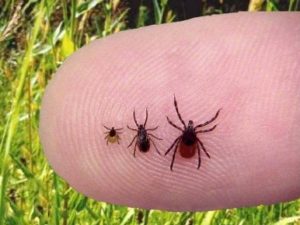How to Protect Yourself From Ticks and Leeches When Hiking

How to Protect Yourself From Ticks and Leeches When Hiking
Posted on
Hiking isn’t all fun and games out in the wilderness and at times we need to be aware of the not so nice parts of nature that have the opportunity to put a dampener on proceedings. Both ticks and leeches appear at different times of the year in most states so being aware of their potential to impact your hike and the ways in which to prevent and treat their appearance is vital. It doesn’t take much to adjust your gear to avoid such nasties and the risk of picking up something terrible (in the case of ticks) will be minimised.
Leeches
Let’s start with the slimier but less dangerous of the two, the blood sucking leech. Found in the wetter and tropical areas of the country, the Australian leech variety is gaining a bit of a reputation in the medical community to assist in the treatment of several ailments. While this practice used to be more widespread and eventually thought to be archaic, they are making a comeback in the medical field.
This of course does not help when you are wading through some thick mud or a particularly reedy section of the trail and you discover several of the suckers have come along for the ride. Leeches are crafty parasites, sensing your imminent arrival through the vibrations you make or the heat you give off and then attaching themselves to anything they can using suckers, of which they have one located at either end of the body. One of these ends contains a mouth, which pierces the skin, releases a anticoagulant to prevent the blood clotting and then they feast until they are full.
A lot of the time leeches are harmless and you don’t even know they are there. When they have finished feeding they will simply drop off the skin but if you do find a few of them still going to town on your blood supply then there are a few methods to removing them. There are various tips and tricks from around the world but the safest method is to just let them fall off naturally. If you get squeamish about these things and don’t feel like waiting around then you can use a combination of salts, tea tree oil or pulling them off with your fingers. Dousing the leech with salts or chemicals can lead it to vomit up its stomach, bringing with it the risk of unwanted bacteria. If you decide to pull them off with your bare hands then make sure to dab the area with an antiseptic cream to avoid infections caused by leftover teeth.
Leeches are pretty hard to avoid if you are in an area that has a large population but some methods that people have had some luck with include using insect repellent, waterproof sunscreen, wearing stockings (you have an excuse guys!!), long pants and gaiters. Avoiding the areas where leeches are found is also a good idea but sometimes this can’t be avoided when we want to get out on our favourite trails.
 Ticks
Ticks
Unlike leeches, ticks have a pretty deserved and nasty reputation because they don’t only want to bite into our tasty flesh but potentially leave us with lasting problems. Tick borne diseases are a well known occurrence around the world but in Australia it is still weirdly disregarded that there is a thing called Lyme Disease, a condition that can affect your organs and bodily functions quite severely. If you aren’t sure about Lyme Disease or want to find out more, you can get more information here (http://www.lymedisease.org.au/about-lyme-disease-2/).
The appearance of ticks coincides with the warmer weather that is found in late spring and summer as they reach maturity so be extra careful around this time. They love hanging around in grasses and leafy trees, which unfortunately describes most trails found in Australia. Luckily ticks are a bit easier to prepare for than leeches and are fussy about what they will grab on to. Long sleeved shirts and trousers are a must, especially if you can get them in the slippery moisture wicking fabric that most adventure clothing comes in as the ticks can’t get a proper grip and will most likely slip off onto the ground.
An application of insect repellent that contains DEET is also a handy way of warding off the parasites or if you avoid DEET products then a eucalyptus or tea tree based spray will be good protection also. When you are on the trail then take a break every now and then to visually check your persons for any hitchhikers. In my experience they won’t bite straight away and I’ve certainly found a few crawling around on the drive home after a summer hike so it’s best to do your checks when you are standing on terra firma. When you do arrive home and want an extra level of protection then put your clothes in a hot clothes dryer for 20-30 minutes to kill any ticks that may have avoided detection and are just waiting for the right time to strike.
If you are unfortunate enough to have a tick bite then recent research from Mona Vale Hospital in New South Wales is here to help. Dr Andy Ratchford and his team concluded that killing a tick by freezing it before removal was the safest way to do it with only 10% of people who used this method having an allergic reaction to the tick as opposed to 40-50% that removed them without killing them (http://www.dailytelegraph.com.au/newslocal/manly-daily/research-reveals-best-way-to-remove-a-tick/news-story/2c1433d9e2e29cd73a8baf8d601186b2). Does this mean you have to carry around a freezer or big container of liquid nitrogen on every hike then? Thankfully the answer is no, a simple application of WART-Off for the larger ticks and a permethrin-based cream like Lyeclear for the tiny ticks will be sufficient. You will have to wait for the tick to fall off but that’s a small price to pay to avoid a potentially severe allergic reaction. If the tick doesn’t fall off within a few hours then please seek medical help.
While we always worry about snakes, spiders and crocodiles in Australia, it is the smaller stuff that can do more harm to more people, as is the case with ticks. Wearing the right gear and knowing what to do when confronted with these nasty creepy crawlies. Ticking all the right boxes in your preparation means these issues won’t leech the fun from your trail experience.
-Mark Pybus
Guest blogger




